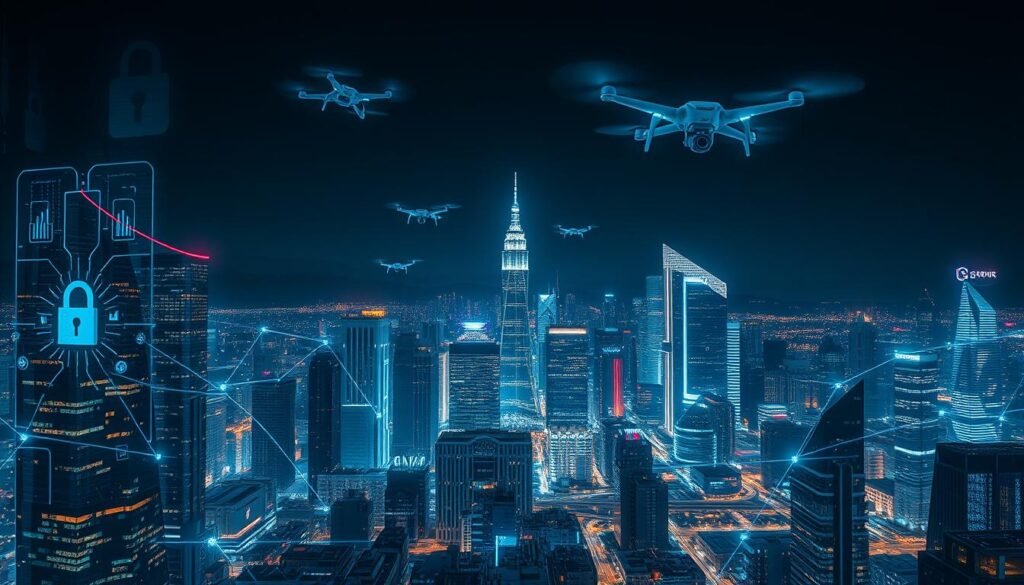Did you know that jobs for information security analysts are expected to jump by 31% from 2019 to 2029? The Bureau of Labor Statistics says so1. This shows how important cybersecurity is as our digital world keeps changing. Cyber threats are getting more complex, so we need new tech to fight them.
Larry Ellison, CTO of Oracle Corporation, says we need automated cyber defense2. Also, these risks are hurting our economy and digital growth2. To tackle these issues, companies are using AI, machine learning, and hybrid cloud systems. These tools are changing how we protect our digital world.
Key Takeaways
- • The employment of information security analysts is projected to increase by 31% from 2019 to 2029.
- • Organizations face rising cyber threats, making automated defenses critical for protection.
- • The economic consequences of cybersecurity risks hinder digital transformation and economic growth.
- • AI and machine learning are pivotal technologies influencing the cybersecurity landscape.
- • Emerging risks with cloud computing emphasize the need for innovative security solutions.
The Importance of Cybersecurity in a Digital Era
In today's world, cybersecurity is more important than ever. Cyber threats are getting more common, and companies must protect their data. A data breach in 2023 cost an average of $4.45 million, showing the high cost of poor security3.
Almost half of UK businesses faced a cyberattack in the last year. This shows how widespread and harmful these attacks can be4.
Companies face many cyber risks, like malware and phishing attacks5. Human mistakes, like clicking on bad links, are a big reason for breaches3. This makes it crucial to have strong security plans, including risk checks and training for employees3.
Cybersecurity protects computer systems from unauthorized access. Without it, companies can suffer from bad reputation and lost trust, as seen in the 2018 British Airways breach4. It's vital to invest in good security systems to stay safe in today's cyber world3.
Emerging Technologies Reshaping Cybersecurity
Cybersecurity is changing fast, thanks to new technologies. AI, blockchain, and IoT security are leading this change. Let's explore three key advancements.
Artificial Intelligence (AI) and Machine Learning
AI and machine learning are revolutionizing how we fight cyber threats. About 50% of executives believe AI will make cyber attacks more sophisticated6. AI can quickly spot unusual patterns and predict threats, making responses faster.
Blockchain Technology in Cybersecurity
Blockchain is becoming a key player in keeping data safe and reducing fraud. Its decentralized system helps protect sensitive info from cyber attacks. As more companies use blockchain for security, it's becoming a strong tool for safe transactions.
Internet of Things (IoT) Security Solutions
IoT devices bring new challenges to network security. Smart cities need strong IoT security to protect against cyber threats. Working together, governments, tech companies, and cybersecurity experts must find effective solutions7.
Cloud Security: Opportunities and Challenges
More companies are moving to cloud environments, making cloud security more important. The spending on public cloud services is expected to jump by 20.7% this year. It will reach about $592 billion, up from $490 billion in 20228. This growth brings new cloud technology threats that need to be tackled.
Many companies are worried about their cloud environments. A huge 95% of security experts are concerned about public cloud security. They worry about data loss and leakage at 69%, and data privacy and confidentiality at 66%9. Misconfiguration is a big threat, with 59% of cybersecurity pros naming it their top concern. Yet, only one in five organizations regularly checks their cloud security8.
To better protect data in the cloud, businesses need to take several steps. They should use multifactor authentication, strong data encryption, and strict access controls. Sadly, 82% of cloud security breaches happen because of a lack of employee skills, showing the need for constant training8. With 80% of organizations facing serious cloud security issues last year, the need for skilled workers is critical9.
| Concerns in Cloud Security | Percentage |
|---|---|
| Data Loss and Leakage | 69% |
| Data Privacy and Confidentiality | 66% |
| Accidental Exposure of Credentials | 44% |
| Misconfiguration | 59% |
Current Cybersecurity Trends to Watch
Keeping up with cybersecurity trends is key for businesses to boost their security. The digital world is seeing more data breaches, with a 72% rise in 202310. All types of organizations face threats, especially from state-backed hackers11. Governments are also tightening cybersecurity rules11.
Technology's growing complexity brings new risks, especially in IoT where security is often weak11. With 79% of companies hit by breaches in 18 months, cloud services are a big concern10. An effective plan to handle cyber threats is essential. AI and machine learning can help by analyzing data in real-time12.
Training employees is more important than ever. 88% of breaches come from simple mistakes like weak passwords and phishing10. By focusing on resilience, your company can face threats better and handle more data12.

Cybersecurity Challenges in the Future
Understanding the future of cybersecurity is key as risks grow. Today, companies face many challenges, like ransomware and social engineering. It's crucial to protect data and keep operations running smoothly.
Ransomware Attacks on the Rise
Ransomware is a big problem in cybersecurity. It's getting more common and complex, putting pressure on companies to pay up. To fight it, having good backups and response plans is vital.
Companies need to keep improving their defenses. They also must teach employees about security. This way, they can stay ahead of ransomware attacks13.
The Impact of Social Engineering
Social engineering is a big threat in cybersecurity. It tricks people into sharing secrets. This method is very effective because it relies on people's mistakes.
Studies show that 95% of breaches come from human errors14. As tech gets better, so do the tricks used by hackers. Companies must focus on training and using better technology to fight these tactics.
The Future of Cybersecurity: Emerging Technologies and Challenges
The world of cybersecurity is changing fast. New tech like AI, IoT, and cloud computing are becoming part of our lives. They bring both chances and dangers for keeping our data safe15.
AI can help find and fight cyber threats better. But, it can also be used by hackers to create smart malware15.
IoT devices are everywhere, making life easier but also risking our security. Over half of hospital IoT devices can be hacked, showing how urgent strong security is16. Companies must stay alert to new threats as hackers keep finding new ways to attack15.
Cloud computing will play a big role in the future, with 85% of companies going cloud-first by 202516. This makes big data targets for hackers. Social engineering, like phishing, is still a big problem, hitting over 72% of businesses worldwide16.
Companies need to keep learning and getting ready for these new threats. Investing in security tech will pay off by 2030, showing how crucial it is17. The focus will shift to being able to bounce back from attacks, not just prevent them17.

Skills Gap: The Shortage of Cybersecurity Professionals
The cybersecurity skills gap is a big problem for companies in many fields. As cyber threats grow, finding the right people to protect against them is hard. There are about 663,434 job openings for cybersecurity experts in the U.S., but only 1.1 million people in this field18. This means many companies don't have enough skills to fight off threats18.
Indeed, 70% of companies say this talent shortage makes them more vulnerable19.
Impact on Organizations
The lack of cybersecurity experts has big effects on businesses. It can lead to burnout and high turnover, weakening teams20. It also makes it harder to quickly respond to cyber threats, giving attackers more chances to strike20.
As a result, 92% of companies say they have gaps in their cybersecurity skills19.
Strategies for Addressing the Skills Gap
Companies can take steps to fill the cybersecurity skills gap. Investing in education and training helps grow the talent pool20. Working with schools for internships can also help train the next generation of cybersecurity experts20.
Reskilling IT staff is another good strategy. It uses their existing knowledge and reduces the need for new hires20. Short training programs and certifications can also help people quickly improve their cybersecurity skills20.
It's also important to keep cybersecurity awareness high in companies. Human mistakes cause about 88% of cyberattacks. Regular training helps prevent these errors20. With the need for more cybersecurity workers growing by 145%, companies must act fast to stay safe19.
International Collaboration in Cybersecurity
In the fight against cyber threats, international cybersecurity cooperation is key. Organizations and governments worldwide work together to fight cybercrime. The Budapest Convention on Cybercrime is a big step, helping countries follow the same cybercrime policies.
But, national security interests can slow things down. They make it hard to work together21.
By 2025, cybercrime damages could hit $10.5 trillion a year. This shows how urgent it is for strong international rules22. Countries need to share intelligence and best practices to fight cyber threats.
The rise in cyber-attacks, like the big DDoS attack on France, shows we need to work together22.
Working together can make countries stronger against cyber threats. Sharing intelligence and forming joint task forces are important steps. Having good cybercrime policies that understand the global digital world is a win for everyone.

The Role of Regulations in Cybersecurity Advancements
The world of cybersecurity regulations is always changing. This means companies must keep up with laws like GDPR and CISA. In 2023, 71% of companies felt the effects of a lack of cybersecurity skills23.
Laws focus on data protection laws to keep information safe. This makes companies use strong cybersecurity. They must do this to avoid big fines for data breaches under GDPR24.
Businesses need to know and follow compliance standards well. A scary fact is that 93% of companies plan to share some cyber risk with security service providers in the next two years23. This move is a smart way to deal with the growing number of cyber threats.
Companies worry about legal trouble if they get hacked. They might face lawsuits from customers or partners. To avoid this, investing in cybersecurity tech and doing audits is key24.
Having a solid legal plan for cyber attacks is also important. It helps all teams work together to fight cyber threats.
The Evolution of Cyber Insurance
As threats online grow, cyber insurance is becoming key for risk management.
The cyber insurance market has grown fast, with premiums doubling since 2015. In 2018, it hit $1.1 billion for standalone policies25. Experts predict it will hit USD 480 billion in commercial premiums by 204026.
The cost of cybercrime worldwide is expected to jump to USD 13.82 trillion by 202826. Ransomware claims have skyrocketed, with costs over 500% higher since 201526.
Not all sectors buy cyber insurance at the same rate. Large businesses are more likely to have it, with 58% having standalone policies. Only 21% of small businesses have it25. Education and Healthcare lead in adoption, with 66% and 62% respectively25.
Cyber insurers are getting better at handling risks by improving underwriting and offering more services27. This push for better security means companies must step up their game to get better coverage.
Prices for cyber insurance can change a lot due to market shifts, new tech, and a lack of past data26. This makes cyber insurance a big chance but also a big risk in the insurance world.
Technological Innovations and Cybersecurity Practices
Technological advancements are changing how we handle cybersecurity. The global cybersecurity market was worth $202.72 billion in 2022 and is growing. This shows we need strong safety measures for the future28.
Every 39 seconds, a cyberattack happens. This means organizations must boost their defenses quickly28.
Artificial Intelligence (AI) and Machine Learning (ML) are key in cybersecurity. They help find and analyze threats faster. This makes our defenses stronger against cybercrimes29.
The Internet of Things (IoT) market is growing fast. It's expected to have over 75.4 billion devices by 2025. This means we need strong security to protect these devices28.
Cloud services are used by most businesses. But, 45% of them have faced a data breach in the cloud. As the cloud market grows, so does the need for better security28.
Biometric authentication is becoming more popular. It offers better security than old methods. It helps protect sensitive data better30.
Organizations should share threat information to stay safe. Training users to spot threats is also crucial. Understanding the good and bad sides of new tech is key to a safer digital world29.
Conclusion
The future of cybersecurity is both challenging and full of opportunities. It's crucial for you to use future-focused strategies. Organizations need to invest in new technologies like artificial intelligence and blockchain to boost their security.
These technologies are key in fighting cyber threats and improving how we detect and respond to them31.
Working together between the public and private sectors is also important. This teamwork helps create a safer cybersecurity plan. It's vital for sharing information and staying ahead of cyber threats.
Small and medium-sized businesses face unique challenges due to limited resources. They need help to stay secure32.
Looking ahead, we need a strong security system. This requires new tech and a skilled workforce. We must also focus on training the next generation of cyber defenders.
Teaching them both technical skills and critical thinking is essential. This way, we can better defend against complex attacks33. By working together, we can create a safer digital world.




